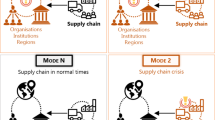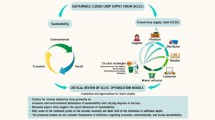Abstract
A new e-Service model called dynamic supply chain is characterized by their dynamic nature in easily being formed and disbanded with the seamless connectivity provided by e-Marketplace. The new term “supply mesh” was coined to represent this virtual community of companies in which dynamic supply chains, as per project (also known as make-to-order), are formed across different tiers of suppliers. In a supply mesh, a dynamic supply chain can be formed vertically, from the top to the bottom layers, mediating different companies for a project. Companies that are on the same level laterally are usually competitors, and the companies that are linked vertically as supply chains are trading partners. From a global view, the companies that are connected in the supply mesh can be viewed as individual entities that have self-interest. They may compete for survival as well as collaborate with each other for jobs. Given such complex relations the challenge is to find an optimal group of members for a dynamic supply chain in the supply mesh. A multi-agent model called the collaborative single machine earliness/tardiness (CSET) model was recently proposed for the optimal formation of make-to-order supply chains. This paper investigates the possibilities of applying CSET in a supply mesh, and the corresponding allocation schemes are experimentally studied in simulations. One scheme called Cost-driven principle leads to destructive competition while the other one namely Pareto-optimal evolves into a cooperative competition that tries to mutually benefit every participant. The results, based on samples from the U.S. textile industry, show that a cooperative competition scheme is superior in terms of optimal allocation, which obtains maximum satisfaction for all participants.























Similar content being viewed by others
References
Banker, S. (2005). The global, make-to-order supply chain: Is it time to examine alternative models, ARC insights. Dedham: Allied Drive.
Billesbach, T. J. (1991). A study of implementation of just-in-time in the United States. Production and Inventory Management Journal, 32(3), 1–4.
Buyya, R., Abramson, D., Giddy, J. (2000). An economy driven resource management architecture for global computational power grids. Proceeding of International Conference on Parallel and Distributed Processing Techniques and Applications.
Chavez, A., & Maes, P. (1996). Kasbah. An agent marketplace for buying and selling goods. Proceedings of the First International Conference on the Practical Application of Intelligent Agents and Multi-Agent Technology.
Cook, R. L., & Rogowski, R. A. (1996). Applying JIT principles to process manufacturing supply chains. Production and Inventory Management, 1st Quarter, 12–17.
Davidson, J. D., & Rees-Mogg, W. (1999). The sovereign individual: Mastering the transition to the information age, 380.
Fudenberg, D., & Tirole, J. (1983). Game theory, MIT Press, chapter 1, section 2.4.
Harland, C. M. (1996). Supply chain management: Relationships, chains and networks. British Journal of Management, 7, 63–80.
Hobbs, O. K. (1994). Application of JIT techniques in a discrete batch job shop. Production and Inventory Management, 1st quarter, 43–47.
Holsapple, C., Lai, H., & Whinston, A. (1995). Analysis of negotiation support systems: Roots, progress, and needs. The Journal of Computer Information Systems, 35(3), 2–11.
Holsapple, C., Lai, H., & Whinston, A. (1997). Implications of negotiation theory for research and development of negotiation support systems. Group Decision and Negotiation, 6(3), 255–274.
Holweg, M., & Pil, F. (2004). The second century: Reconnecting customer and value chain through build-to-order. Cambridge, MA and London, UK: The MIT Press.
Homburg, C., & Schneeweiss, C. (2000). Negotiations within supply chains. Computational & Mathematical Organization Theory, 6(1), 47–59.
Homburg, C., Koschate, N., & Hoyer, W. D. (2006). The role of cognition and affect in the formation of customer satisfaction: A dynamic perspective. Journal of Marketing, 70(3), 21–31.
Kim, H. S., Cho, J. H., Choi, H. R., Hong, S., Kang, M. H. (2006). Optimal supply chain formation using agent negotiation in a SET model-based make-to-order. Proceedings of International Conference on Electronic Commerce, 579–583.
Koch, R. (2001). The 80/20 principle: The secret of achieving more with less. London: Nicholas Brealey Publishing.
Kropotkin, P. (2005). To alter or to abolish, chapter 5: All against all, Darrell Anderson.
Lau, H. C., & Zhang, L. (2004). A two-level framework for coalition formation via optimization and agent negotiation. Proceedings of the intelligent Agent Technology, IEEE Computer Society, 441–445.
Lau, H. C., Zhang, L., Liu, C. (2005). Solving generalized open constraint optimization problem using two-level multi-agent framework. Proceedings of the IEEE/WIC/ACM international Conference on intelligent Agent Technology (September 19–22, 2005). IEEE Computer Society, 558–564.
Li, C., & Li, L. (2012). Collaboration among mobile agents for efficient energy allocation in mobile grid. Information Systems Frontiers, 14(3), 711–723.
Li, H., Ahn, D., Hung, P. C. K. (2004). Algorithms for automated negotiations and their applications in information privacy. Proceedings of the IEEE International Conference on E-Commerce Technology, 255–262.
Lim, L., & Benbasat, I. (1993). A theoretical perspective of negotiation support systems. Journal of Management Information Systems, 9(3), 27–44.
Liu, R., & Kumar, A. (2011). Leveraging information sharing to configure supply chains. Information Systems Frontiers, 13(1), 139–151.
Lo, G., & Kersten, G. E. (1999). Negotiation in electronic commerce: Integrating negotiation support and software agent technologies. Proceedings of 5th Annual Canadian Operational Research Society Conference.
Monden, Y. (1981). Adaptive Kanban system helps Toyota maintain just-in-time production. Industrial Engineering, 13(5), 29–46.
Nam, I. H. (2003). Benefit of supply chain coordination. Seoul Journal of Business, 9(1).
Nowell, C. H. (2005). Market competitiveness in the global textile supply chain: Examination of supply chain configurations. MSc Thesis, North Carolina State University.
Putten, S., Robu, V., Poutré, H., Jorritsma, A., Gal, M. (2006). Auto-mating supply chain negotiations using autonomous agents: A case study in transportation logistics. Proceeding of International Conference in Autonomous Agents, the International Workshop on Agent Theories, 1506–1513.
Rangaswamy, A., & Shell, G. R. (1997). Using computers to realize joint gains in negotiations: Toward an electronic bargaining table. Management Science, 43(8), 1147–1163.
Smith, A. (1950). An inquiry into the nature and causes of the wealth of nations. London: Methuen.
Temponi, C., & Pandya, S. Y. (1995). Implementation of two JIT elements in small-sized manufacturing firms. Production and Inventory Management Journal, 3rd Quarter, 23–29.
Tian, J., Foley, R., Yao, X., Tianfield, H. (2006). An extended contract net mechanism for dynamic supply chain formation and its application in China petroleum supply chain management. Multiagent and Grid Systems, 183–207.
Walker, W. (2004). “Supply chain flexibility”. Montgomery Research ASCET 6.
Wigand, R. T., & Benjamin, R. I. (1995). Electronic commerce: Effects on electronic markets. Journal of Computer-Mediated Com-Munication, 1(3).
Yang, H., Fong, S., Zhuang, Y. (2008). Applying Pareto-optimal and JIT techniques for supply chains. Proceeding of International Conference on Hybrid Intelligent Systems, 308–313.
Yang, H., Fong, S., & Zhuang, Y. (2010). CSET automated negotiation model for optimal supply chain formation. World Review of Science, Technology and Sustainable Development (WRSTSD), 7(1/2), 67–78.
You, F., & Grossmann, I. E. (2007). Optimal design and operational planning of responsive process supply chains. Process Systems Engineering, Wiley.
Author information
Authors and Affiliations
Corresponding author
Rights and permissions
About this article
Cite this article
Yang, H., Fong, S. Optimizing dynamic supply chain formation in supply mesh using CSET model. Inf Syst Front 15, 569–588 (2013). https://doi.org/10.1007/s10796-012-9380-y
Published:
Issue Date:
DOI: https://doi.org/10.1007/s10796-012-9380-y




